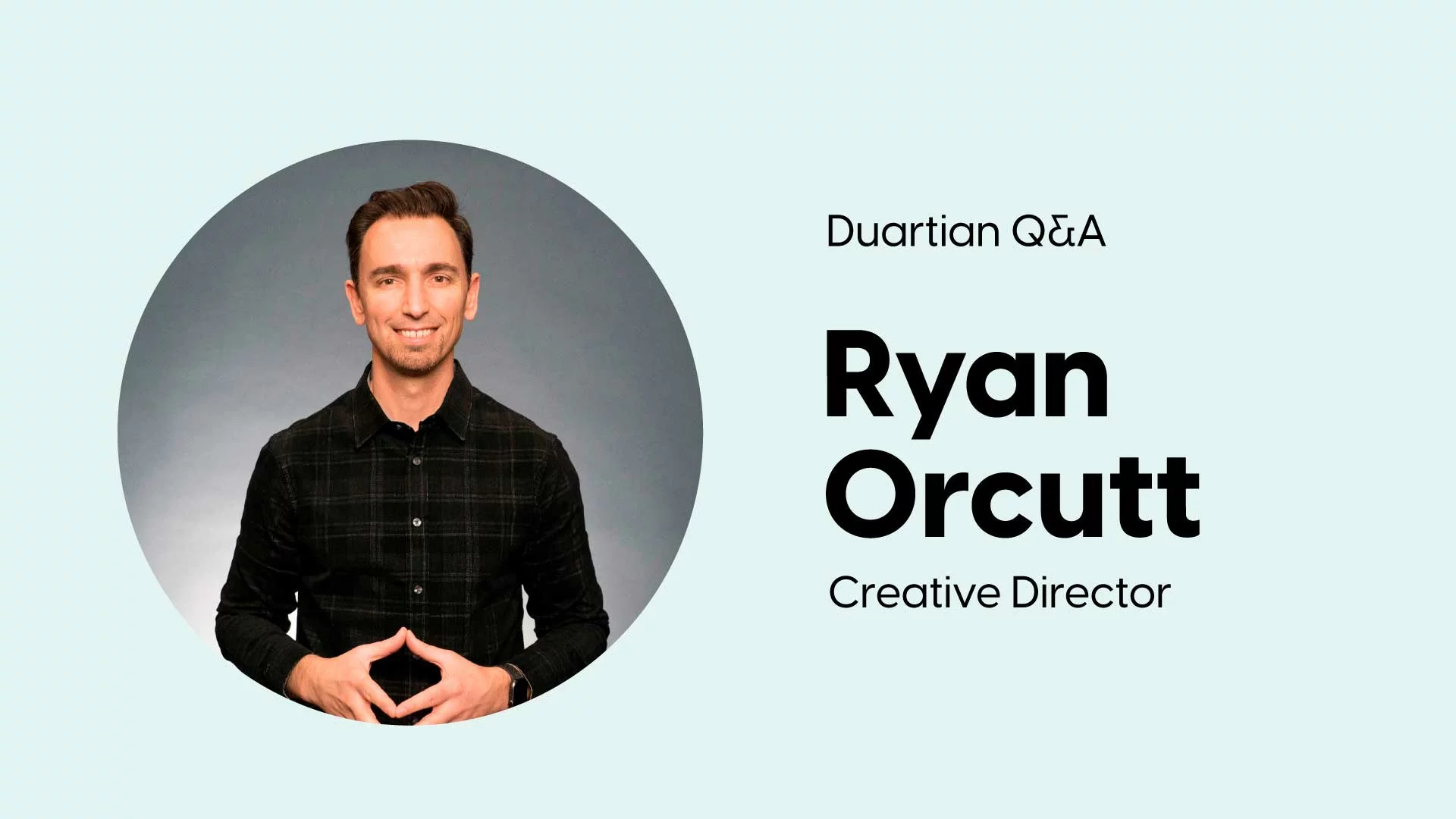Q&A: How to influence through visual storytelling
 In our recent webinar, “Influence Through Visual Storytelling”, we received many thoughtful questions about using visuals in presentations. In part one of this two-part blog post, our host, Ryan Orcutt, creative director, head of design at Duarte, answers the top questions received so you can learn to think, speak, and work like a designer.
In our recent webinar, “Influence Through Visual Storytelling”, we received many thoughtful questions about using visuals in presentations. In part one of this two-part blog post, our host, Ryan Orcutt, creative director, head of design at Duarte, answers the top questions received so you can learn to think, speak, and work like a designer.
Do I always need to present with a set of slides? Does everything need to be visualized?
No, you don’t always need slides. Some stories are best told without visuals so the audience can focus on the story and connect with you, as the storyteller, emotionally. Think about the stories told around the campfire or with family around the dinner table. In addition, we’ve helped more than one client learn to “live sketch” their message instead of creating slides. It’s a more informal and a more intimate way to communicate.
Similarly, not all of your content needs to be visualized. In general, you should visualize the key message you want the audience to understand or take away—and keep the slide free from content that distracts. The rest of the content can be addressed verbally, but not visualized.
At Duarte, do you often craft and deliver A&B versions of the same presentation content (e.g., an in-person slide deck and asynchronous document)?
Yes, we’ll often make both a visual presentation and an accompanying Slidedoc. When you’re making two versions of the same communication, it’s important to have a consistent visual language. So, before you create either piece, make sure you’ve defined the color palette, font system, style of photography, illustration, icons and so on. Having this established will keep the two pieces unified.
Additionally, it’s important to finish the full script for the presentation before you start making either version. Once you have the full script you can decide what gets simplified and visualized for the talk and what remains (or even beefed up) for the Slidedoc. Whatever you do, avoid making a hybrid version that “works” for both styles of communication. When you do that, it ends up not serving either purpose effectively.
When should you build a presentation versus a leave-behind or pre-read?
The main difference is that a presentation has the benefit of a speaker. The visuals and the speaker’s voice work together in a choreographed dance to lead the audience through the content. A leave-behind or a pre-read is self-directed without the help of a speaker. Therefore, more words and detailed diagrams may be required as part of the visuals to explain and deliver the content effectively.
Are there any tools that will make visualizing ideas easier for people without graphic design skills?
Duarte has a 90-minute self-led online course called Slide Design that can help boost your confidence with PowerPoint, while also learning some design fundamentals. That course, plus a combination of stock photography and illustration is probably your best route. As another DIY option, I’ve also seen Canva used effectively by non-designers.
Sometimes, I need to show and explain complex, ill-structured theoretical models and systems when I present. What are effective techniques for these visuals?
When showing complex diagrams, try to avoid unveiling it all at once and instead reveal it piece by piece, slowly building it from the foundation. Pacing the reveal in this way gives the audience time to process the information and leads to better comprehension. You can also use a highlight and lowlight technique for showing one part of the diagram while dimming out the rest. You can also slowly move around the diagram explaining one piece at a time until the audience understands the complete picture.
What apps/tools do you use to sketch digitally?
There are lots of options in this category, but personally, I use Procreate, Adobe Sketch, and PowerPoint.
Can you use whiteboarding or sketching collaboratively to influence or encourage people to consider new ideas?
Absolutely. I find sketching on a whiteboard, or any surface really, to be a highly effective tool for illustrating new ideas. That’s because I’ve found sketching, ideas feel less precious, less finished. It creates more open space for ideation and brainstorming, encouraging others to participate. Whiteboarding and sketching can help facilitate alignment in ways that finished, polished slides sometimes can’t.
What’s better: PowerPoint, Keynote, or Google Slides?
We consider ourselves technology agnostic and use the application that makes the most sense for the client that we’re working with. It used to be that if you wanted to work collaboratively, Google Slides made the most sense. But now all the apps have this capability. Use the app that most people at your company use. This will improve adoption/use of the deck if that’s a goal.
How do you feel about animation used in presentations? What about in Zoom meetings?
Simple, purposeful animation is an essential tool for creating a compelling presentation. Animation can help pace the content and give the audience what they need, right when they need it. It can help to create emphasis and to annotate key parts of slides. Used intentionally, animation adds beautiful visual interest and can create transitions that feel cinematic vs. sequential. But animation should be purposeful and intentional. Don’t go overboard. When done poorly, animation can be very distracting and create confusion.
Where is the best place to get stock images?
We primarily use Getty Images, Stocksy, and iStock because we can transfer the usage rights to our clients and because the photo libraries are massive. There are other “free” resources like Unsplash, but when used for business we prefer to be able to purchase the license.
How do you use transitions effectively?
Use transitions to do two things…
To connect slides together to create sequences. When done well, the audience won’t be able to tell when you’ve “clicked” to the next slide. It will feel seamless and fluid. More like moving through scenes in a movie than clicking through slides in a presentation.
To signal to the audience that you’re moving to a new section. These transitions will feel more abrupt and obvious than the other transitions. They may make use of a contrasting color or a new type of motion that feels different than what’s used in other places.
Do you prefer light or dark backgrounds?
Conventional thinking has taught us that dark backgrounds work best in large event spaces or theaters where you can control the lighting of the room, and that lighter backgrounds should be used in smaller spaces like boardrooms. In my personal experience, I’ve seen light and dark used effectively in both environments. And in my opinion, the choice of the background should be more connected to the mood you’re trying to create, or the visual style you’re going for and less driven by the size of the room.
For more expert visual design advice from Ryan Orcutt and answers to other questions asked, watch the complete “Influence Through Visual Storytelling” webinar on-demand here.
Illustrated by Alexis Macias
TOPICS:
Business, Communication, Presenting, Visual Thinking
RELATED COURSES
Learn from the pros
Gain insight on effective presentation strategies
From developing presentation skills to designing PowerPoint® presentations, we invite you to join the 200,000 people who leverage our extensive resource library.


